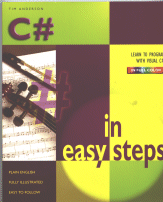This is not a review. I've written this book, and what I'm offering here is the rationale behind it. First, let me emphasize that this is a book for beginners. If you are already a programmer or developer, it is probably not for you.
I had several goals in writing this book.
First, I wanted the reader to be up and running with working applications as soon as possible. . This book follows a "by example" approach, and although it is a short book there are over a hundred example applications in it. The idea is that this is satisfying and motivating, and that readers learn by doing. Generally each example illustrates just one or two points. They are stripped down to bare essentials.
Second, although this is a beginner's book I wanted to do some justice to key programming concepts including object orientation. Chapter three covers language essentials, with such things as data types, casting, value types and reference types, and the role of the mysterious curly bracket. Chapter four introduces object orientation, explaining inheritance, overloading and overriding, static members, and object lifetime. Although these may seem difficult concepts for beginners, they are things that to my mind you need to know in order to make sense of building applications. The explanations are as simple as I can make them, and there are still lots of short examples.
Third, I'm mindful that the programmer today has instant access to a huge range of resources, starting with online help and continuing with the Internet. There's no point in trying to compete with these other resources. I've actually included guidance on how to use online help, and some tips on searching the Web. What a book can provide is a consistent course and guide, and a starting point for further learning and exploration. My aim is to build confidence through the many working examples.
This is a book about Windows programming with Visual Studio, not a pure C# tutorial. That means it includes an introduction to the key Visual Studio tools as well as C# programming. This makes sense to me since most people will be using these tools.
I've also included chapters on database programming and creating Internet applications with ASP.NET web forms. Again you could argue that these topics are too advanced for beginners. My thinking is that they are too important to ignore. So there is a simple introduction to ADO.NET, which is the database framework in Microsoft .NET, again with working examples. I've then shown how the same data can be displayed on a web site with ASP.NET. There are explanations of essential features such as code-behind, isPostBack and the Session object.
This is not a book for purists. It covers a wide range of topics, and it cannot possibly be comprehensive and detailed. On the other hand, if you work through the book and build all the examples you will have a good grasp both of programming essentials and of what you can do with today's Windows programming tools.
Finally, a few practical details. This book is in the Easy Steps series, which uses the idea of numbered steps with plentiful illustrations to enable readers to create the examples. Unlike early books in the series, C# in Easy Steps is in full colour throughout. It's modestly priced, and all the examples are available to download here.
How to buy C# in Easy Steps
C# in Easy Steps at Barnes and Noble
C# in Easy Steps at Amazon.co.uk
Copyright Tim Anderson 23rd August 2004. All rights reserved
